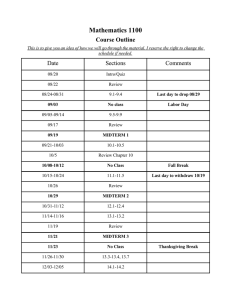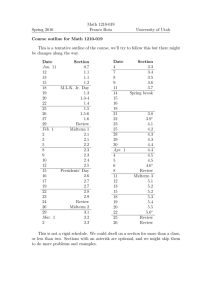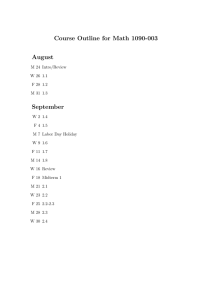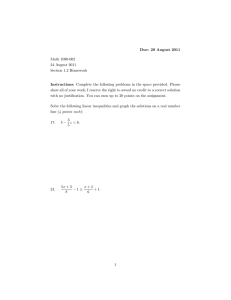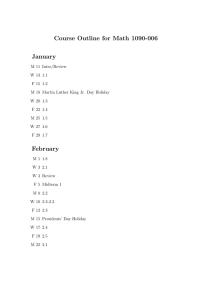Summary of Syllabus for ECON-110: The Global Majority
advertisement
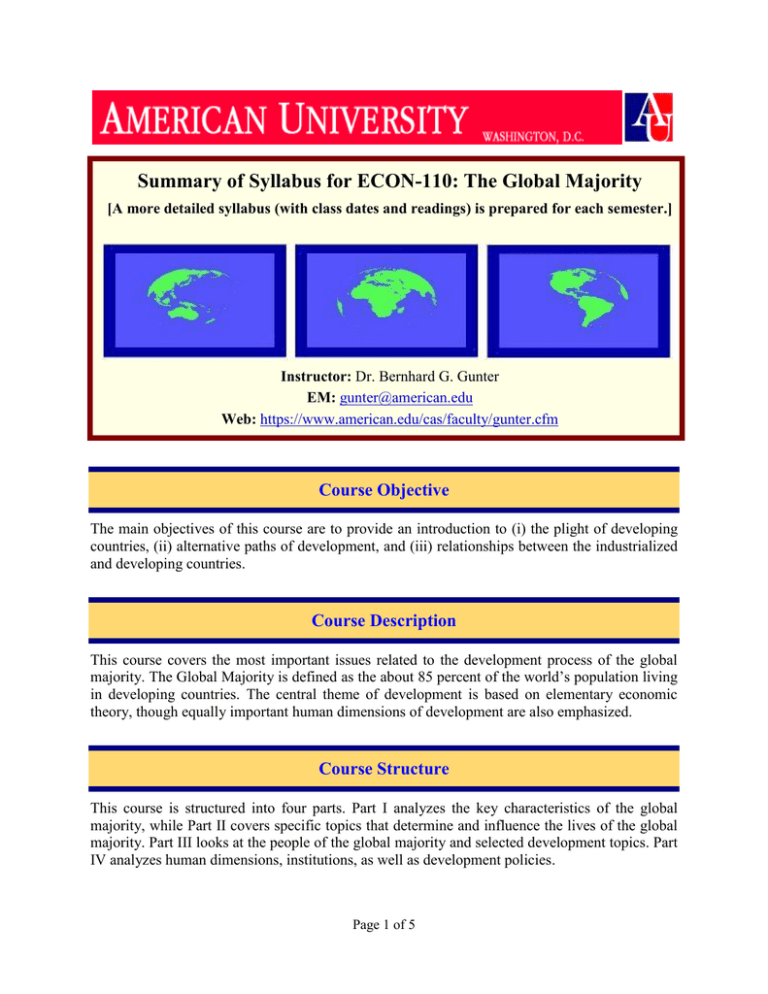
Summary of Syllabus for ECON-110: The Global Majority [A more detailed syllabus (with class dates and readings) is prepared for each semester.] Instructor: Dr. Bernhard G. Gunter EM: gunter@american.edu Web: https://www.american.edu/cas/faculty/gunter.cfm Course Objective The main objectives of this course are to provide an introduction to (i) the plight of developing countries, (ii) alternative paths of development, and (iii) relationships between the industrialized and developing countries. Course Description This course covers the most important issues related to the development process of the global majority. The Global Majority is defined as the about 85 percent of the world’s population living in developing countries. The central theme of development is based on elementary economic theory, though equally important human dimensions of development are also emphasized. Course Structure This course is structured into four parts. Part I analyzes the key characteristics of the global majority, while Part II covers specific topics that determine and influence the lives of the global majority. Part III looks at the people of the global majority and selected development topics. Part IV analyzes human dimensions, institutions, as well as development policies. Page 1 of 5 Course Outline Part I: Key Characteristics of the Global Majority Class 1: Class 2: Class 3: Class 4: Class 5: Class 6: Introduction: Who is the Global Majority, what is PPP-adjusted GDP, and the MDGs The Global Majority is Poor: Poverty is a Multi-dimensional Phenomenon The Global Majority is Heterosexual: Population Growth, Gender Issues, Population Politics The Global Majority is Young: Children are Our Future The Global Majority Lives in Cities: Urbanization and Development Research Clinic: What You Need to Know about Writing Your Research Paper Part II: Specific Topics that Determine or Influence the Lives of the Global Majority Class 7: Class 8: Class 9: Class 10: Class 11: Class 12: Agriculture: The Lifeline of the Global Majority Climate Change: Threatening the Global Majority Power, Poverty, and the Global Water Crisis The Global Majority: Unsustainably Indebted The Global Majority: Lacking Access to Credit Midterm Exam (Covering Parts I and II) Part III: The People of the Global Majority & Selected Development Topics Class 13: Class 14: Class 15: Class 16: Class 17: Class 18: Class 19: Class 20: Class 21: Class 22: First Movie (covering South Asia; likely: City of Joy) South Asia, especially India & Structural Transformation Second Movie (covering Africa; likely: Blood Diamond) Africa & the Resource Curse Research Clinic: How to Create Graphs with Excel The Bottom Billion & Poverty Traps China & Contrasting a Centrally Planned Economy with a Market Economy Latin America, especially Brazil & Production Possibility Curve & International Trade The Former Soviet Republics, especially Russia & the Role of Institutions The Middle East, especially Saudi Arabia & Iran & the Rentier State Part IV: Human Dimensions, Institutions and Policies Class 23: Class 24: Class 25: Class 26: Class 27: Class 28: Class 29: Class 30: The Global Majority: Facing Human Rights Violations The Global Majority and Globalization: Being Driver, Driven, or Excluded? Governing the Global Majority: The State and the United Nations The Millennium Development Goals (MDGs) & Country-level Processes to Achieve Them Recommendations for the International System & Costs and Benefits of Achieving the MDGs Review of Parts I-II Review of Parts III-IV Final Cumulative Exam Page 2 of 5 Course Resources a.) Academic Support Center and CAS Writing Center [“we are here for you”] AU’s Academic Support Center (ASC) and the Writing Center of the College of Arts and Sciences (CAS) provide various services and programs for any student at American University who would like help in developing the tools necessary for their success. Please see http://www.american.edu/ocl/asc/index1.html and http://www.american.edu/cas/writing/index.cfm for further details. b.) Blackboard/EM [“technology is the future”] This course will use AU’s Blackboard software. Please check your AU E-mail for any announcements. It is your responsibility to check your AU E-mail. I acknowledge every EM I get. If you do not get my reply within a reasonable time, please check if you sent it to the correct address (gunter@american.edu) and/or follow up with me. c.) Reading Material [“reading is fundamental”] Reading material is classified into i) required, ii) light, or iii) optional reading. (i) You should read all required reading carefully. (ii) You can skim through the light reading. (iii) Optional reading provides further details. Some of it may be useful for your research paper. While you are encouraged to read some of the optional reading material, it is in no way necessary material to excel in this course. All optional reading material is available in the Reserve section of the Bender Library. All required and light reading will be available electronically. It is your personal choice, possibly reflecting your learning style, to read the material before or after class. One advantage of reading the material before class is that you might understand the topic covered in class more easily. One advantage of reading the material after class is that you will know on what to focus within the required reading. While some of the reading may seem unnecessary as we cover the most important issues in class, the readings will help you to a) understand and b) memorize the most important issues. Experience has shown that students who systematically study the reading material are typically the ones who excel in the final exam. d.) Documentaries and Movies [“a picture is a thousand words”] This course includes the viewing of documentaries and movies that illustrate some aspects of this course. The selected documentaries and movies are an integral part of this course. In addition to various short documentaries shown in class, there will also be cinematic movies shown in addition to regular classes. If you miss a movie, it is your responsibility to make it up, e.g., by viewing it in the Bender Library. Page 3 of 5 Grading Grading will be based on homework sets (10 percent), one midterm exam (15-25 percent), one research paper (25 percent) and one cumulative final exam (40-50 percent). Given that you are still at a learning stage at the time you take the midterm, the percentage at which the midterm counts towards your course grade depends on how much better your final exam is than your midterm. If your final exam is the same (or worse) than the midterm, the midterm counts for 25 percent and the final counts for 40 percent. If your final exam is one grade better than your midterm, the midterm counts for 20 percent and the final counts for 45 percent. If your final exam is at least two grades better than your midterm, the midterm counts for 15 percent and the final counts for 50 percent. Grading Scale for Homework (HW) Midterm (M) Research Paper (RP) Final Exam (F) Course 10 percent 15-25 percent 25 percent 40-50 percent of course grade (average of 5 best HW) of course grade of course grade of course grade =0.1*HW + (0.15 or 0.20 or 0.25)*M + 0.25*RP + (0.5 or 0.45 or 0.4)*F M Points Grade Credits 95-100 A 10 90-94.9 A9 85-89.9 B+ 8 80-84.9 B 7 75-79.9 B6 70-74.9 C+ 5 65-69.9 C 4 60-64.9 C3 55-59.5 D 2 RP Points Grade Credits 47.5-50 A 10 42.5-47 A9 37.5-42 B+ 8 32.5-37 B 7 27.5-32 B6 22.5-27 C+ 5 17.5-22 C 4 12.5-17 C3 7.5-12 D 2 F Points Grade Credits 180-200 A 10 170-179.5 A9 160-169.5 B+ 8 150-159.5 B 7 140-149.5 B6 130-139.5 C+ 5 120-129.5 C 4 110-119.5 C3 100-109.5 D 2 HW Points Grade 31.0-35.0 A 28.0-30.9 A25.0-27.9 B+ 22.0-24.9 B 19.0-21.9 B16.0-18.9 C+ 13.0-15.9 C 10.0-12.9 C7.0-9.9 D < 7.0 F Credits 10 9 8 7 6 5 4 3 2 1 < 55 F 1 < 7.5 F 1 < 100 F 1 Credits above 9.49 8.50 - 9.49 7.50 - 8.49 6.50 - 7.49 5.50 - 6.49 4.50 - 5.49 3.50 - 4.49 2.50 - 3.49 1.50 - 2.49 Grade A AB+ B BC+ C CD less than 1.50 F Academic Integrity Please note that the academic integrity code is strictly enforced for all homework, exams and the research paper. Violations of the Academic Integrity Code will not be treated lightly, and disciplinary actions will be taken should such violations occur. If you have not already done so, please familiarize yourself at: http://www.american.edu/academics/integrity/code.htm. Community-Based Learning & Research This course allows you to earn a fourth credit via Community-Based Learning & Research. If you are interested, please see: www.american.edu/ocl/volunteer/CBLR-Community-Based-Learning-and-Research-homepage.cfm and let me know your ideas/suggestions. There are a variety of international & multi-cultural organizations you may pick from; please see: http://www.american.edu/ocl/volunteer/upload/International-Multicultural-Organizations-2.pdf. Page 4 of 5 AU’s General Education Program a.) General Education Program Goals The six goals of AU’s General Education Program are: (i) (ii) (iii) written and oral communication; critical thinking, including information literacy; ethics; (iv) aesthetics; (v) perspectives of race, class, culture, and gender; and (vi) a global point of view. The Global Majority obviously focuses on the sixth goal (a global point of view), though it also addresses written communication, critical thinking, ethics (especially human rights), and perspectives of race, class, culture and – last but not least – gender. b.) Curricular Area Goals The Global Majority is one of the five foundation courses in Cluster One (Global Perspectives) of Curricular Area 3 (Global and Multicultural Perspectives) in the University's General Education Program. The specific goals of this curricular area are to: (i) explore those habits of thought and feeling that distinguish regions, countries, and cultures from one another; (ii) discuss, in comparative and cross-cultural perspective, the concepts, patterns, and trends that characterize contemporary global politics; and (iii) develop your capacity to critically analyze major issues in international and intercultural relations, especially how categories of difference are organized within and across cultures and how they affect political systems. While The Global Majority touches on each of these goals, it focuses on the lives of the global majority— the about 85 percent of the world’s population who live in low- or middle-income countries. Like all courses in this area, The Global Majority encourages a better understanding of the dimensions of experience and belief that distinguish cultures and countries from one another and, conversely, the commonalities that bind human experience together. If you take this course as part of AU’s General Education Program, this foundation course is part of a course cluster which must be followed in sequence by an appropriate second level-course in the same cluster; please see: http://www1.american.edu/american/registrar/geninfo/gened3.htm. c.) Standards for Performance Evaluation Evaluation of a student’s performance in this course as a whole will be guided by the following criteria: A: Demonstration of superior work in fulfillment of course requirements. B: Excellent work in fulfillment of course requirements. C: Satisfactory work in fulfillment of course requirements. D: Assigned work is not satisfactory or not completed. F: Failure to meet minimum course goals and requirements. Green Teaching This is a Certified Green Course. This means, for example, that I will not hand out any printed materials, but I will use EM/Blackboard extensively to post handouts, collect assignments, and provide you with feedback on assignments. To help make our class as green as possible, I encourage you to buy used books, minimize paper use, and read course readings online rather than printing copies. If you choose to print, please print double-sided, and recycle the paper after the end of the semester. Page 5 of 5

